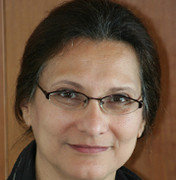Palestinian Independence on the Venice Lido


Ms Mikdadi, the first exhibition at the Biennale is down to your personal initiative. How did you approach the task?
Salwa Mikdadi: Ultimately, it was a collaborative effort. When I first had the idea, I considered entering into a partnership with an artist, gallery owner or curator from Venice. Then I met Vittorio Urbani, director of the Nuova Icona art association, he was enthusiastic and became commissioner of the exhibition.
The Biennale Committee accepted my concept for the project. Nevertheless, I wanted to be sure first of all that there would be sufficient funding for us from Palestinian sources – for me that was the only way of funding this that was acceptable. Then we found a wonderful patron, the Palestinian curator Rana Sadik. This made it possible for the exhibition to become a truly Palestinian, symbolically independent representation of Palestinian artists.
What alternatives for funding might you have had?
Mikdadi: EU art sponsorship programmes, for example, these bodies currently sponsor most art projects in Palestine and much of the rest of the region, with the exception of the United Arab Emirates and the Gulf states. I would not have done the exhibition, though, if that had been the case.
What other sources of funding did you have from Palestine?
Mikdadi: Private individuals in Palestine, the Khalid Shoman Foundation in Jordan, Soha Shoman is the director. She gave us great support. And some charitable organisations too.
There are so many good artists in Palestine. Was it not difficult to decide who to include? What sorts of criteria did you give priority to?
Mikdadi: I decided that I didn't want a conceptual theme running through the whole thing, with appropriate artists chosen to match, but rather individual concepts that I found convincing. I knew the artists and wanted to be sure that they lived in Palestine or grew up there. So there are fewer from the diaspora.
Overall I spent more than three years researching, interviewing and talking to artists, familiarising myself with current art practice in Palestine, getting to know how it is changing, what the latest the developments are. I wanted to involve young, aspiring artists who already have an international reputation.
Artists such as Mona Hatoum do not fit into your scheme?
Mikdadi: I think highly of her and respect her work very much. But this is about what is happening now in Palestine. It is the first exhibition and needs to be representative of contemporary Palestinian art, and about more than just being internationally interesting for others – that was important.
Where does the idea of national identity come into this?
Mikdadi: I did not discuss identity with the artists, for them it's not a big issue. They all know where they come from. There was certainly symbolic art in the past, related to the cultural identity or the iconography, but I was not looking for that. And the Palestinian artists are free to be artists, in whatever way they wish, without being pinned down! That belongs to the past.
When one talks to artists here at the Biennale one discovers that they often have a problem with the idea of representing a nation, many of them don't even live in their home countries anymore. What sort of hybrid is the Biennale? This national idea is not a subject for your artists either?
Mikdadi: It's not any longer! It's not just a question of globalisation, it also has to do with people, with politics – globalisation may have influenced them up to a certain point, of course, but I think that artists have reached a point where one cannot even say this is an issue – in fact, I don't even think it ever was one.
Do you think that your being at the Biennale will change anything with regard to awareness of art in Palestine? Or is the change already happening?
Mikdadi: It is already happening – but this is, without a doubt, a major milestone for the Palestinians! One only needs to look at the numbers of Palestinians on the streets of Venice, that in itself shows how significant the response to this initiative has been. And we were very happy about the success of the opening; with our ambassador to Belgium, with Luisa Morgantini and representatives from the city of Venice.
Apparently there is still room in Palestine for such art to be created, in spite of tensions and repression?
Mikdadi: Yes, why not? As our poet Mahmud Darwish said: We can be who we are, so that we can have happiness and fun. That means writing songs, poetry and humour. Why must everything be a reaction to Israel?
Talking about Israel: Do you think that a two-state solution is the best way forward for the region?
Mikdadi: I personally believe that a single-state solution would be best.
How would you envisage that, where would the borders be?
Mikdadi: In the historical Palestine, that will be shared by everyone.
Interview: Irmgard Berner
© Qantara.de 2009
Qantara.de
Interview with Mona Hatoum
"The Idea Is What Matters!"
Palestinian-British artist Mona Hatoum has the gift of visualizing the uncanny in the accustomed, the ludicrous in the banal. Now she was awarded the art prize of the Haftmann Foundation. Urs Steiner and Samuel Herzog spoke with the artist
The Palestinian City of Ramallah
An Oasis in a Cultural Desert
The Palestinian cultural landscape is barren. Those who live in Ramallah are relatively lucky, as the city is the lynchpin of Palestinian culture, an oasis in a cultural desert. A first-hand report by Sebastian Blottner
Interview with Rose Issa
"Culture Should Not Be Restricted to the West"
The Louvre has just signed a lucrative million-euro deal with Abu Dhabi. Critics in France fear a "sell-out" of French culture. In this interview with Lewis Gropp, Rose Issa, independent curator and art critic specialised on Middle East and North Africa, disagrees